Evaluation of Fracture Properties of Two Metallic Materials under Hydrogen Gas Conditions by Using XFEM
Abstract
:1. Introduction
2. Method of Experiments and Analyses
2.1. Experimental Procedure
2.2. XFEM and Multi-Island Genetic Algorithm
2.3. Analysis procedure
3. Evaluation of Slow Strain Rate Tensile Specimen
3.1. Analysis Models and Conditions
3.2. Analysis Results and Discussion
4. Evaluation of Compact Tension Specimen
4.1. Analysis Models and Conditions
4.2. Analysis Results and Discussion
5. Conclusions
- The XFEM damage parameters of the Al6061-T6 alloy and SA372 steel were derived using SSRT specimens. The maximum differences in the load and total displacement between the experiments and analyses were within 5% for all materials and conditions;
- Experiments and analyses on ½T-CT specimens made of SA372 steel were performed in the presence of noble and hydrogen gases. For both cases, fracture resistance curves were compared. The differences in JQ values in the presence of noble and hydrogen gases were 8.4 kN/m and 4.1 kN/m, respectively. This suggests that the analysis method was reasonable;
- The JQ value of SA372 steel was determined following the ASTM 1820 standard. The JQ value in the presence of 62.5 MPa hydrogen gas was observed to be significantly lower (by a factor of 88.1%) than that in the presence of 62.5 MPa noble gas;
- The JQ values of the Al6061-T6 alloy were derived in a similar manner, and it was observed to be lower by only 3.8% for the ½T-CT specimen in the presence of 10 MPa hydrogen gas. This suggests that the behavior of Al6061-T6 alloy is not affected by hydrogen gas.
Author Contributions
Funding
Data Availability Statement
Conflicts of Interest
References
- Robertson, I.M.; Sofronis, P.; Nagao, A.; Martin, M.L.; Wang, S.; Gross, D.W.; Nygren, K.E. Hydrogen Embrittlement Understood. Metall. Mater. Trans. B 2015, 46, 1085–1103. [Google Scholar] [CrossRef]
- Safyari, M.; Moshtaghi, M.; Kuramoto, S.; Hojo, T. Influence of microstructure-driven hydrogen distribution on environmental hydrogen embrittlement of an Al–Cu–Mg alloy. Int. J. Hydrogen Energy 2021, 46, 37502–37508. [Google Scholar] [CrossRef]
- Safyari, M.; Moshtaghi, M.; Kuramoto, S. On the role of traps in the microstructural control of environmental hydrogen embrittlement of a 7xxx series aluminum alloy. J. Alloys Compd. 2021, 855, 157300. [Google Scholar] [CrossRef]
- Matsuoka, S.; Yamabe, J.; Matsunaga, H. Criteria for determining hydrogen compatibility and the mechanisms for hydrogen assisted, surface crack growth in austenitic stainless steels. Eng. Fract. Mech. 2016, 153, 103–127. [Google Scholar] [CrossRef]
- Nguyen, T.T.; Park, J.; Kim, W.S.; Nahm, S.H.; Beak, U.B. Effect of low partial hydrogen in a mixture with methane on the mechanical properties of X70 pipeline steel. Int. J. Hydrogen Energy 2020, 45, 2368–2381. [Google Scholar] [CrossRef]
- Nguyen, T.T.; Heo, H.M.; Park, J.; Nahm, S.H.; Beak, U.B. Damage assessment and mechanical performance of Cr-Mo steel used in hydrogen storage vessels. Eng. Fail. Anal. 2021, 120, 105031. [Google Scholar] [CrossRef]
- Zhou, D.; Li, T.; Huang, D.; Wu, Y.; Huang, Z.; Xiao, W.; Wang, Q.; Wang, X. The experiment study to assess the impact of hydrogen blended natural gas on the tensile properties and damage mechanism of X80 pipeline steel. Int. J. Hydrogen Energy 2021, 46, 7402–7414. [Google Scholar] [CrossRef]
- Guy, P.; Laszlo, T.; Julien, C. Effects of Hydrogen Addition on Design, Maintenance and Surveillance of Gas Networks. Processes 2021, 9, 1219. [Google Scholar] [CrossRef]
- Sérgio, E.R.; Antunes, F.V.; Neto, D.M.; Borges, M.F. Study on the Influence of the Gurson–Tvergaard–Needleman Damage Model on the Fatigue Crack Growth Rate. Metals 2021, 11, 1183. [Google Scholar] [CrossRef]
- Belytschko, T.; Black, T. Elastic crack growth in finite elements with minimal remeshing. Int. J. Numer. Methods Eng. 1999, 45, 601–620. [Google Scholar] [CrossRef]
- Fageehi, Y.A. Fatigue Crack Growth Analysis with Extended Finite Element for 3D Linear Elastic Material. Metals 2021, 11, 397. [Google Scholar] [CrossRef]
- Kim, D.H.; Sim, J.M.; Chang, Y.S.; Baek, U.B. Hydrogen gaseous effects on fracture resistance of API-X70 estimated by XFEM. J. Mech. Sci. Technol. 2021, 35, 3829–3835. [Google Scholar] [CrossRef]
- Neri, F.; Rostami, S. Generalised Pattern Search Based on Covariance Matrix Diagonalisation. SN Comput. Sci. 2021, 2, 171. [Google Scholar] [CrossRef]
- Pyo, C.; Kim, J.; Kim, J. Estimation of Heat Source Model’s Parameters for GMAW with Non-linear Global Optimization—Part I: Application of Multi-island Genetic Algorithm. Metals 2020, 10, 885. [Google Scholar] [CrossRef]
- Dassault Systems. ABAQUS User’s Manual Ver. 2020. Available online: https://help.3ds.com/2020/english/dssimulia_established/SIMULIA_Established_FrontmatterMap/sim-r-DSDocAbaqus.htm?contextscope=all&id=9a5d7bf209394446819332b397a93f40 (accessed on 9 August 2022).
- Dassault Systems. Isight User’s Manual Ver. 2020. Available online: https://help.3ds.com/2020/english/dssimulia_established/SIMULIA_Established_FrontmatterMap/sim-r-DSDocIsight.htm?contextscope=all&id=436c7e04627c44b8972c6ef47f3da711 (accessed on 9 August 2022).
- ASTM International. ASTM G142-98 Standard Test Method for Determination of Susceptibility of Metals to Embrittlement in Hydrogen Containing Environments at High Pressure, High Temperature, or Both; ASTM International: West Conshohocken, PA, USA, 2011. [Google Scholar]
- ASTM International. ASTM E8/E8M-08 Standard Test Methods for Tension Testing of Metallic Materials; ASTM International: West Conshohocken, PA, USA, 2008. [Google Scholar]
- ASTM International. ASTM G129-00 Standard Practice for Slow Strain Rate Testing to Evaluate the Susceptibility of Metallic Materials to Environmentally Assisted Cracking; ASTM International: West Conshohocken, PA, USA, 2006. [Google Scholar]
- ASTM International. ASTM 1820-13 Standard Test Method for Measurement of Fracture Toughness; ASTM International: West Conshohocken, PA, USA, 2013. [Google Scholar]
- Kim, D.H.; Je, S.Y.; Chang, Y.S. Investigation of cracking behaviors in divertor armor-blocks under cyclic loading. Fusion Eng. Des. 2021, 169, 112464. [Google Scholar] [CrossRef]
- Gairola, S.; Jayaganthan, R. XFEM Simulation of Tensile and Fracture Behavior of Ultrafine-Grained Al 6061 Alloy. Metals 2021, 11, 1761. [Google Scholar] [CrossRef]
- Yang, K.; Zhang, Y.; Zhao, J. Elastoplastic Fracture Analysis of the P91 Steel Welded Joint under Repair Welding Thermal Shock Based on XFEM. Metals 2020, 10, 1285. [Google Scholar] [CrossRef]
- Hu, X.; Xu, J.; Du, X.; Zhang, Y.; Zhou, F. Research on Fatigue Crack Propagation of 304 Austenitic Stainless Steel Based on XFEM and CZM. Metals 2020, 10, 727. [Google Scholar] [CrossRef]
- Holland, J.H. Adaptation in Natural and Artificial Systems: An Introductory Analysis with Applications to Biology, Control, and Artificial Intelligence; The MIT Press: Cambridge, MA, USA, 1992. [Google Scholar] [CrossRef]
- Goldberg, D.E. Genetic Algorithms in Search, Optimization and Machine Learning; Addison-Wesley Longman Publishing Co., Inc.: Boston, MA, USA, 1989. [Google Scholar]
- Mahanty, D.K.; Maiti, S.K. Experimental and finite element studies on mode I and mixed mode (I and II) stable crack growth—I. Experimental. Eng. Fract. Mech. 1990, 37, 1237–1250. [Google Scholar] [CrossRef]


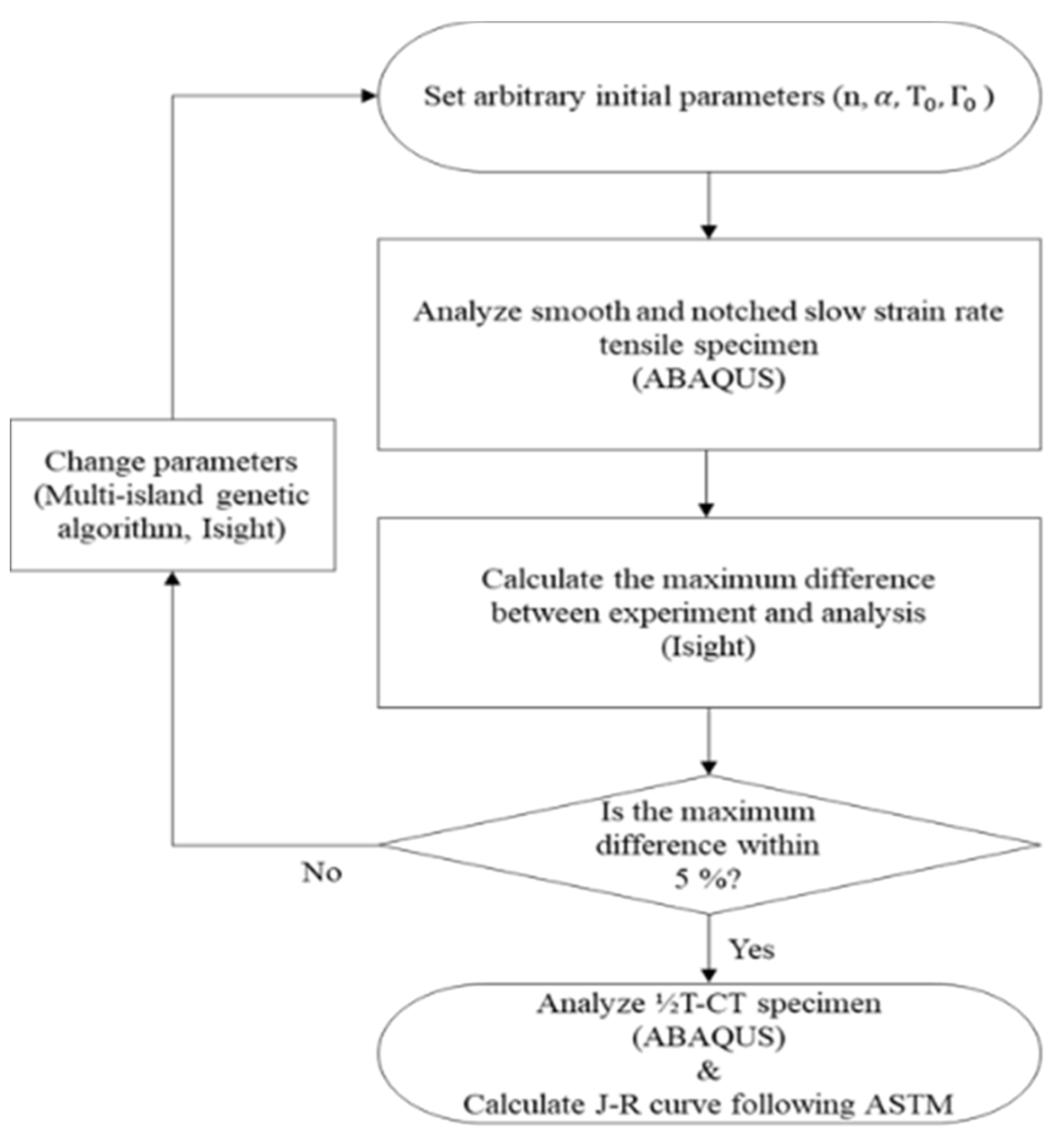
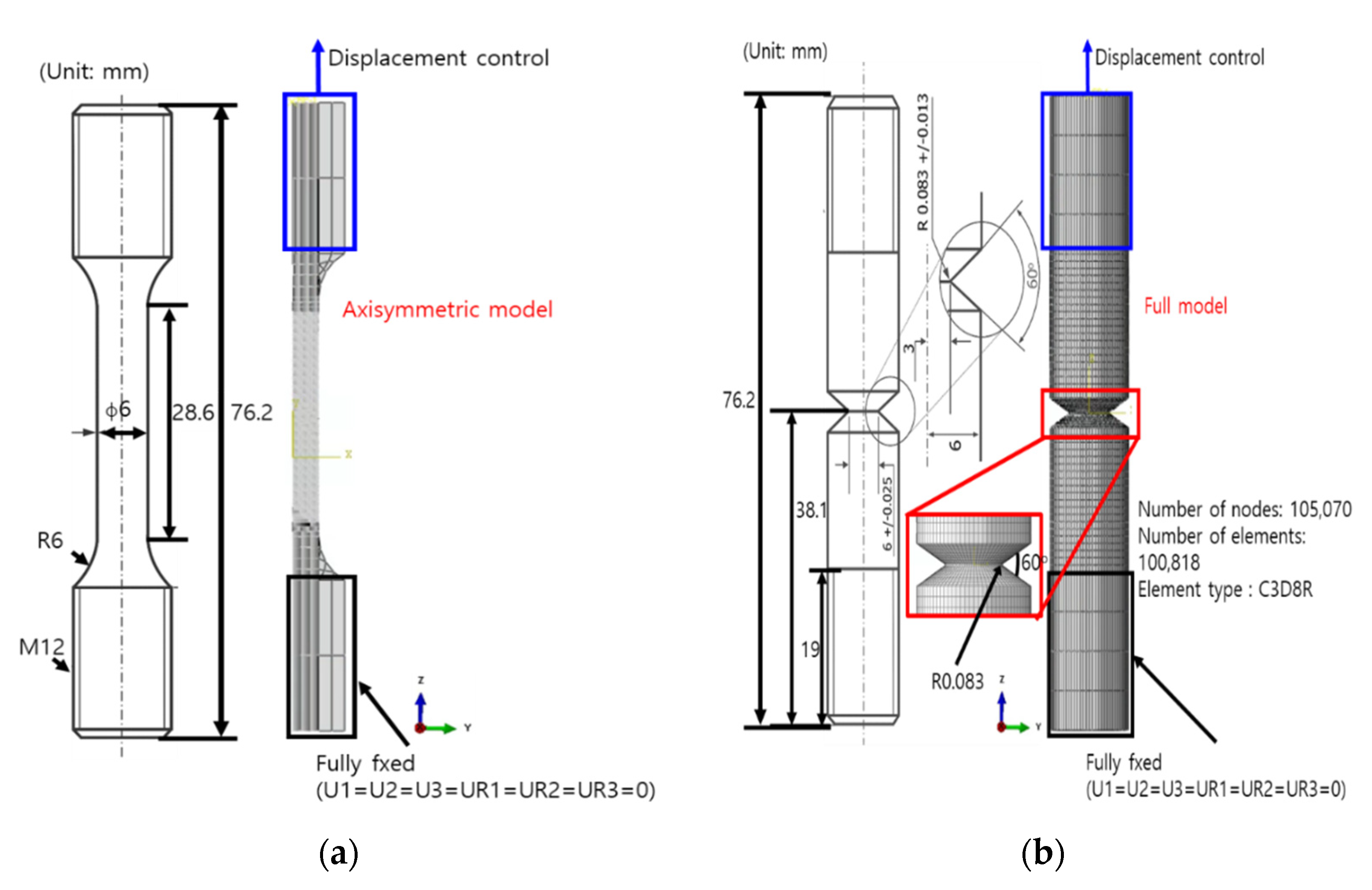

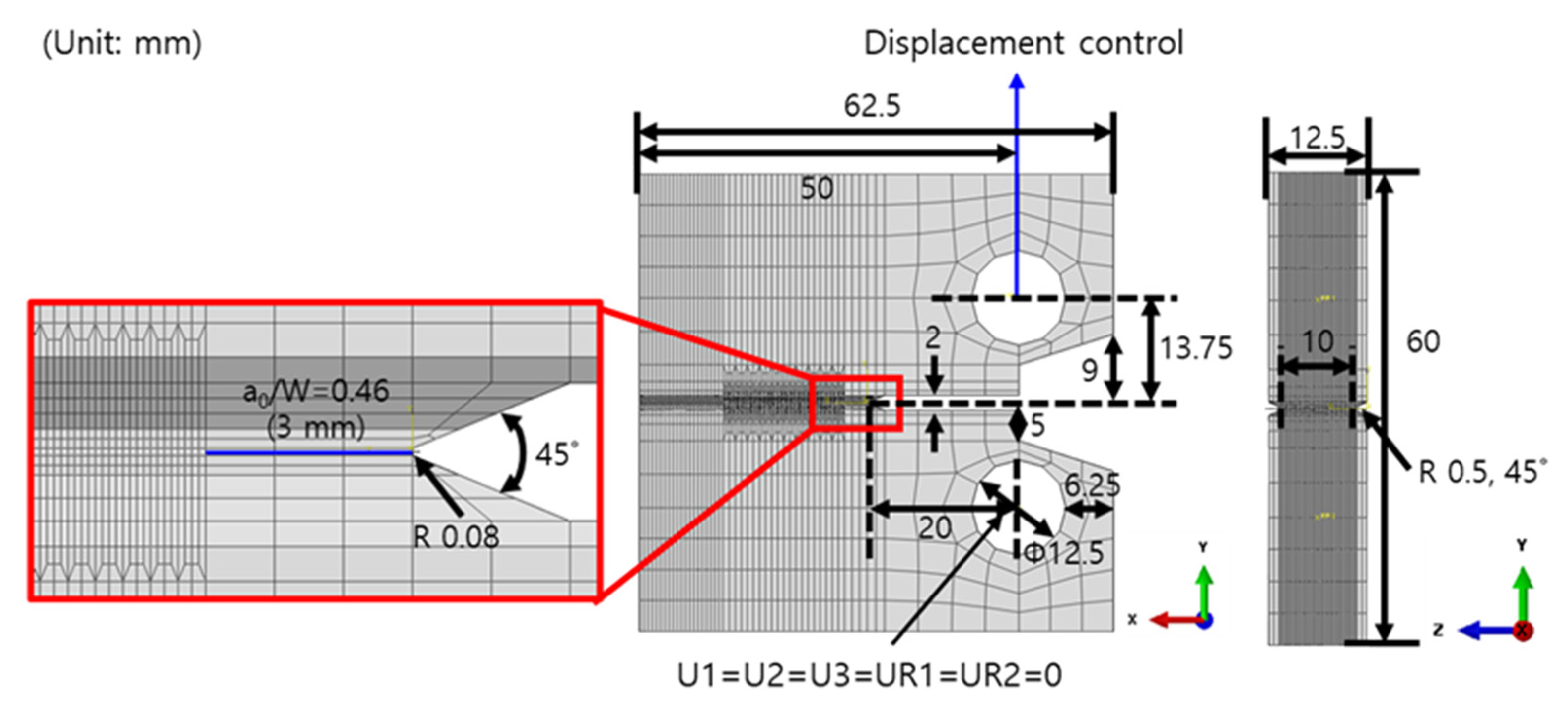
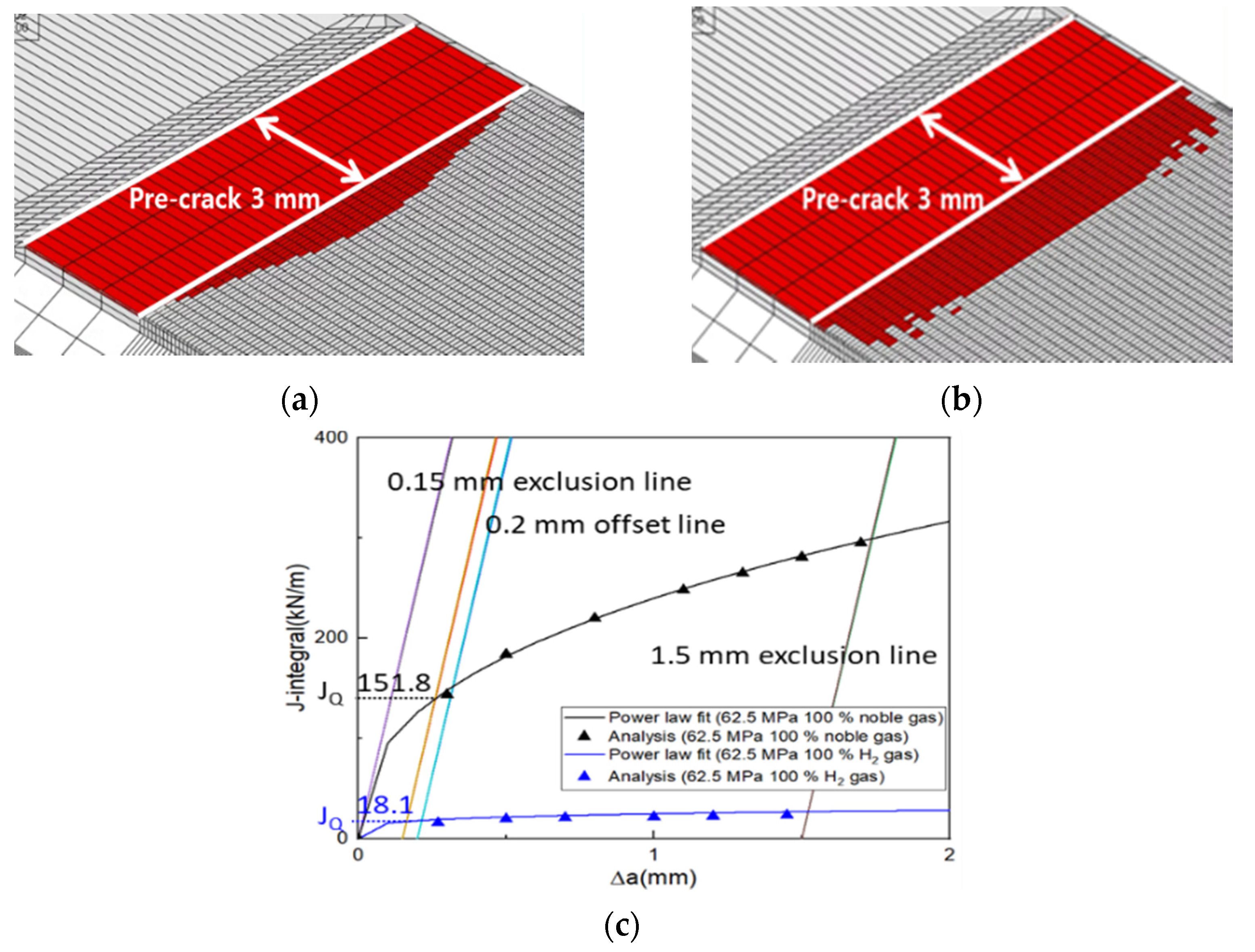
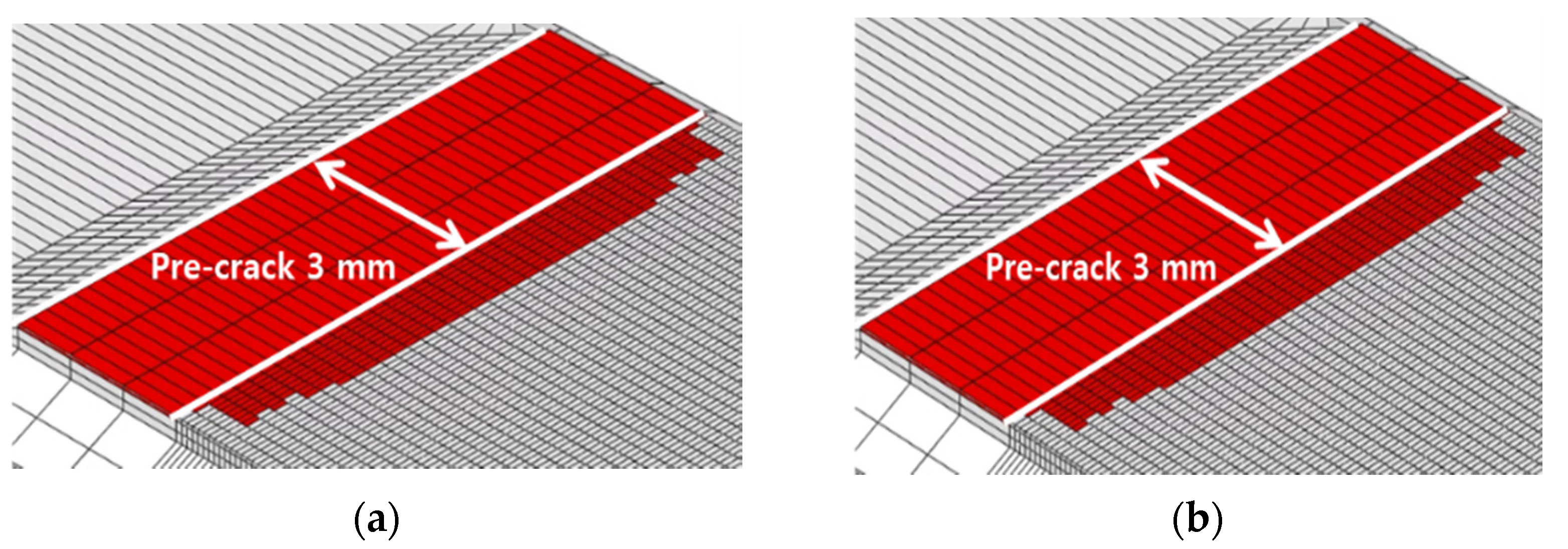
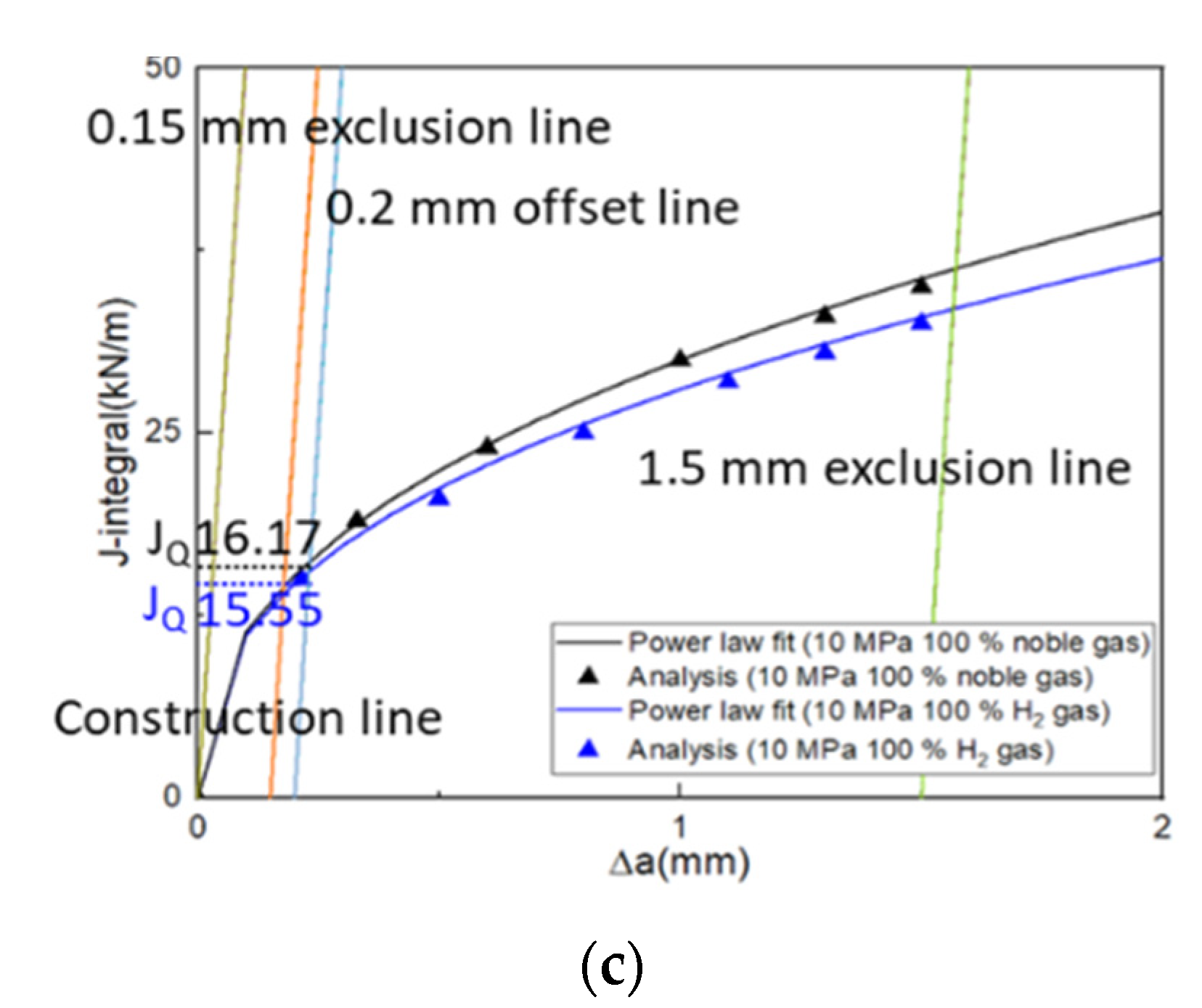
| Parameter | Value |
|---|---|
| Sub-population size | 10 |
| Number of island | 10 |
| Number of generation | 10 |
| Rate of crossover | 1 |
| Rate of mutation | 0.01 |
| Rate of migration | 0.01 |
| Interval of migration | 5 |
| Al6061-T6 | (wt%) | ||||||||
| Si | Fe | Cu | Mn | Mg | Cr | Zn | Ti | Al | |
| 0.4~0.8 | 0.70 | 0.15~0.40 | 0.15 | 0.8~1.2 | 0.04~0.35 | 0.25 | 0.15 | rest | |
| SA372 | (wt%) | ||||||||
| Si | C | P | Mn | S | Cr | Mo | |||
| 0.15~0.35 | 0.35~0.50 | ≤0.024 | 0.75~1.05 | ≤0.015 | 0.8~1.15 | 0.15~0.25 | |||
| Material | Condition | Elastic Modulus [GPa] | Poisson’s Ratio | Yield Strength [MPa] | Ultimate Tensile Strength [MPa] |
|---|---|---|---|---|---|
| Al6061-T6 | 10 MPa 100% noble gas | 69.2 | 0.33 | 252.5 ± 4 | 320.3 ± 8 |
| 10 MPa 100% hydrogen gas | 68.9 | 0.33 | 255.1 ± 5 | 320 ± 4 | |
| SA372 | 62.5 MPa 100% noble gas | 209 | 0.29 | 637 ± 6 | 823.1 ± 13 |
| 62.5 MPa 100% hydrogen gas | 209 | 0.29 | 627.3 ± 16 | 817.1 ± 2 |
| Material | Condition | Cohesive Streght [MPa] | Cohesive Energy [kN/m] | Critical Separation [mm] |
|---|---|---|---|---|
| Al6061-T6 | 10 MPa 100% noble gas | 575 | 100 | 0.35 |
| 10 MPa 100% hydrogen gas | 600 | 60 | 0.2 | |
| SA372 | 62.5 MPa 100% noble gas | 1980 | 50 | 0.05 |
| 62.5 MPa 100% hydrogen gas | 1260 | 180 | 0.28 |
Publisher’s Note: MDPI stays neutral with regard to jurisdictional claims in published maps and institutional affiliations. |
© 2022 by the authors. Licensee MDPI, Basel, Switzerland. This article is an open access article distributed under the terms and conditions of the Creative Commons Attribution (CC BY) license (https://creativecommons.org/licenses/by/4.0/).
Share and Cite
Kim, D.-H.; Park, M.J.; Chang, Y.-S.; Baek, U.B. Evaluation of Fracture Properties of Two Metallic Materials under Hydrogen Gas Conditions by Using XFEM. Metals 2022, 12, 1813. https://doi.org/10.3390/met12111813
Kim D-H, Park MJ, Chang Y-S, Baek UB. Evaluation of Fracture Properties of Two Metallic Materials under Hydrogen Gas Conditions by Using XFEM. Metals. 2022; 12(11):1813. https://doi.org/10.3390/met12111813
Chicago/Turabian StyleKim, Dong-Hyun, Min Jeong Park, Yoon-Suk Chang, and Un Bong Baek. 2022. "Evaluation of Fracture Properties of Two Metallic Materials under Hydrogen Gas Conditions by Using XFEM" Metals 12, no. 11: 1813. https://doi.org/10.3390/met12111813




